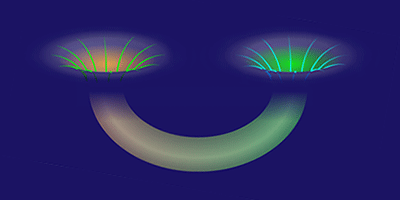Entangled through a Wormhole
Quantum entanglement is weird enough, but it might get weirder still through a possible association with hypothetical wormholes. Over the past year, theorists have been hard at work exploring the entanglement of two black holes. A pair of papers in Physical Review Letters advances the story by showing that a string-based representation of two entangled quarks is equivalent to the spacetime contortions of a wormhole.
A common feature of entanglement and wormholes is that they both seemingly imply faster-than-light travel. If one imagines two entangled particles separated by a large distance—a so-called Einstein-Podolsky-Rosen (EPR) pair—then a measurement of one has an immediate effect on the measurement probabilities of the other, as if information travels instantaneously between them. Similarly, a wormhole—or Einstein-Rosen (ER) bridge—is a “shortcut” connecting separate points in space, but no information can actually pass through. Recent work has shown that the spacetime geometry of a wormhole is equivalent to what you’d get if you entangled two black holes and pulled them apart—an equivalence that can be summarized by “ER = EPR.”
The latest papers in this development extend the equivalence beyond black holes to quarks. As previous studies have shown, two entangled quarks can be represented as the endpoints of a string in a higher dimensional space, where certain calculations end up being easier. Kristan Jensen of the University of Victoria, Canada, and Andreas Karch of the University of Washington, Seattle, imagine the entangled quarks are accelerating away from each other, so that they are no longer in causal contact. In this case, the connecting string becomes mathematically equivalent to a wormhole. Using a different approach, Julian Sonner from the Massachusetts Institute of Technology, Cambridge, has derived the same result starting from quark/antiquark creation in a strong electric field (the Schwinger effect). The wormhole connection may provide new insights into entanglement, as suggested by calculations that equate the entropy of the wormhole to that of the quarks. – Michael Schirber





